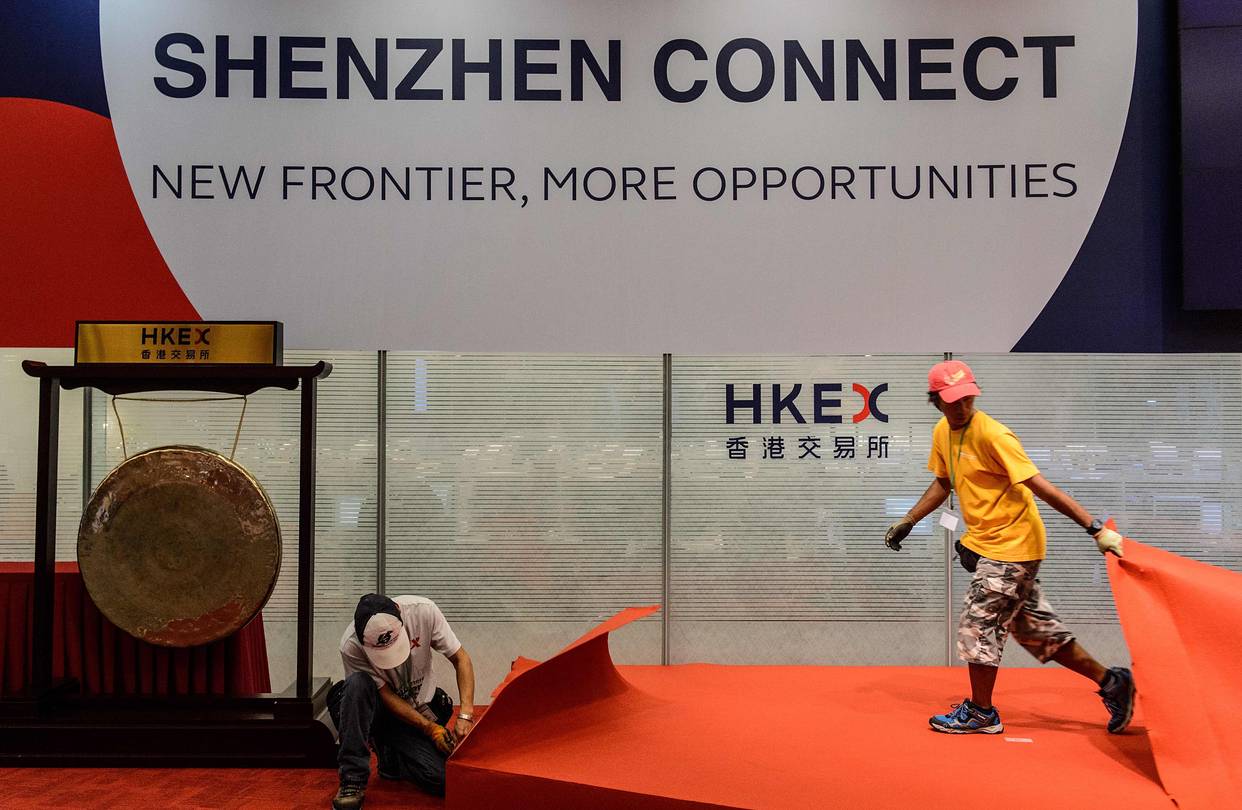At midday break, investment flows into mainland exchange stood at 12% of quota; the other way, 5%

The aftermath of the Hong Kong ceremony marking the opening of a stock-trading link with Shenzhen.
HONG KONG—The opening of a trading link between the Hong Kong and Shenzhen stock markets met with a muted response from investors.
At the midday trading break Monday, investors based outside China had piled around 1.6 billion yuan ($230.5 million) into the Shenzhen market—home to some of the country’s fastest-growing companies in sectors like technology, pharmaceuticals and consumer goods—while Chinese investors had put some 521 million yuan ($75.1 million) into Hong Kong stocks. Those totals represent 12% and 5%, respectively, of the daily limits for the link known as Stock Connect.
The Shenzhen Composite Index was off 0.8%; Hong Kong’s benchmark Hang Seng Index, off 0.3%.
The underwhelming activity comes despite a monthslong buildup, as the opening coincided with a number of events that weighed on global markets during Asian trading hours. Italy’s prime minister resigned after losing a key referendum vote, while U.S. President-elect Donald Trump criticized China’s currency and trade policies via Twitter.
Investors were also shaken by harsh criticism over the weekend from China’s top securities regulator Liu Shiyu of the practice of using borrowed funds to build big stakes in companies, which he called “barbaric” and “industrial robbery.”
The latest Stock Connect allows global investors to trade 881 shares listed in Shenzhen and opens more Hong Kong stocks to mainland Chinese investors. Analysts say the Shenzhen market’s wealth of companies in faster-growing parts of economy could in time make it more attractive to foreign investors than the Shanghai market, dominated more by less dynamic state-owned enterprises such as banks and oil companies.
“There are definitely a few companies that trade in Shenzhen that people have liked for a while but didn’t have easy access to before,” said Joshua Crabb, head of Asian equities at Old Mutual Global Investors. “It’s very natural to see these stocks starting to gain from some institutional attention.” The Shenzhen market is dominated by retail investors, a factor cited in its well-earned reputation for volatility.
In Hong Kong, an opening ceremony for the new Stock Connect was more restrained than the one for a similar link with Shanghai two years ago, as was investor response. On that earlier launch day, around two-thirds of the daily quota for Shanghai shares was used up in the first 45 minutes of trading.
For much of this year, more money has flowed “southbound” through the link—from Shanghai into Hong Kong—than the other way.
Among the Shenzhen-traded companies analysts point to are Hikvision, a video-surveillance provider, Wanda Cinema Line, the world’s biggest movie-theater operator, and Gree, a leading home-appliances maker. Monday’s big winners, though, were lesser-known companies, with video-display maker Shenzhen Silkroad Digital Vision Co. Ltd. and cable maker Nanjing Quanxin Cable Technology both rising by 10%, the daily limit allowed on the exchange.
Some long-term investors seem to have “already done their homework” on Shenzhen, said Nicole Yuen, vice chairman and head of equities for Greater China at Credit Suisse, adding, though, that she expects only gradual growth in northbound trading volume through the link.
“It will not be abrupt,” she said.
Contacts:Manager Gao
Sale dept:
Mob: +86-15932423630
Tel: +86-311-89276065
Email: sales@ht-wiremesh.com
Production Dept:
Tel: +86-318-8063366
Email: 32409058@qq.com
Quality control dept:
Tel: +86-318-8063399
Email: michellegao118@hotmail.com
Complaints dept:
Tel: +86-15932423630
Email: mesh@ht-wiremesh.com
Address:Wire Mesh Zone,Anping County,Hebei Province,China.
